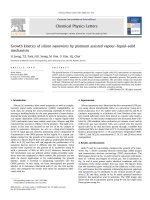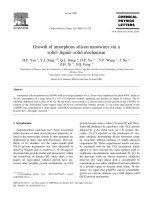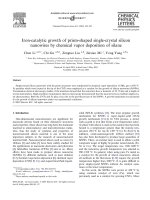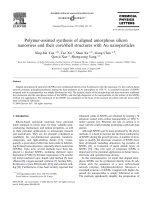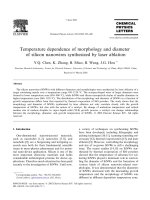- Trang chủ >>
- Khoa Học Tự Nhiên >>
- Vật lý
Infrared spectra of silicon nanowires
Bạn đang xem bản rút gọn của tài liệu. Xem và tải ngay bản đầy đủ của tài liệu tại đây (318.43 KB, 3 trang )
Infrared spectra of silicon nanowires
Junjie Niu
a,
⁎
, Deren Yang
b
, Jian Sha
b,c
, Jian Nong Wang
a
, Ming Li
b
a
School of Materials Science and Engineering, Shanghai Jiao Tong University, Shanghai 200030, People's Republic of China
b
State Key Lab of Silicon Materials, Zhejiang University, Hangzhou 310027, People's Republic of China
c
Department of Physics, Zhejiang University, Hangzhou 310027, People's Republic of China
Received 8 November 2005; accepted 7 June 2006
Available online 28 June 2006
Abstract
Infrared (IR) spectra of the silicon nanowires (SiNWs) with oxide layer are analyzed by introducing the disorder-induced mechanical coupling
between the optically active oxygen asymmetric stretch (AS) and inactive oxygen asymmetric stretch (I-AS) modes in terms of the transverse-optic
(TO) and longitudinal-optic (LO) vibrational modes. The shapes of the IR spectra are similar to that of the reported SiO
2
, indicating that the SiNWs
possess an oxide layer outside. The TO frequencies of coupled AS and I-AS are experimentally observed as peak at approximately 1085 cm
− 1
and its
shoulder of 1200 cm
− 1
, respectively. The other TO absorption peaks of ∼ 468 cm
− 1
, ∼ 480 cm
− 1
, and ∼ 808 cm
− 1
are also observed. Furthermore, the
intensity of the AS-mode TO band centered at ∼ 1085 cm
− 1
decreases while those of silicon lattice absorption peaks are enhanced with the crystalline
quality increased.
© 2006 Elsevier B.V. All rights reserved.
Keywords: Infrared spectra; Nanowires; Silicon
1. Introduction
Silicon nanowires (SiNWs), as an excellent candidate material
for smart nano-devices, have raised extensive interests [1–5].In
general, the oxide layer as the sheath of SiNWs is generated
during fabrication [6]. Because the oxide layer would undertake
electronic interaction in future nano-devices especially in MOS,
understanding of the structural and compositional characteristics
of oxide sheath on SiNWs becomes more significant. In fact, IR
absorption spectra in amorphous SiO
2
(a-SiO
2
) or in silicon wafer
with oxide layer have been detailedly studied for many years [7–
11]. Three obvious IR absorption peaks of 460 cm
− 1
,810cm
− 1
,
and 1070 cm
− 1
in a-SiO
2
have been confirmed. The 1070 cm
− 1
peak was much stronger when the disorder degree of a-SiO
2
was improved [10]. In the analysis of the a-SiO
2
on silicon wafer,
Kirk detailedly explained the IR spectra by the disorder-induced
mode [8].
ForSiNWs,IRabsorptionofSiO
2
on SiNWs has been report-
ed [12,13]. Hu et al. showed an enhanced absorption of SiO
2
/Si
nanowires around 1130 cm
− 1
and 1160 cm
− 1
(LO mode) com-
pared with that of SiO
2
nano-particles [12]. Sun et al. studied
the stabilities and reactivity of hydrogen-terminated surfaces of
SiNWs by FTIR spectroscopy [13]. In this letter, we discussed
the TO frequencies of ∼ 468 cm
− 1
, ∼ 480 cm
− 1
, ∼ 808 cm
− 1
,
∼ 1085 cm
− 1
,and∼ 1200 cm
− 1
in IR absorption spectra of SiNWs
with oxide layer using the disorder-induced mode indicated by
Kirk [8]. The IR data demonstrated that SiNWs were covered with
an oxide layer and undertook a similar phenomenon with SiO
2
.
Moreover, the main AS TO band of ∼ 1085 cm
− 1
was weakened
while those of silicon lattice were strengthened with an increase in
crystalline quality.
2. Experimental procedure
SiNWs were prepared by methods of chemical vapor depo-
sition (CVD) and evaporation methods as reported previously
[3,14]. Sample-I was synthesized by deposition of silane in a
CVD system at ∼ 620 °C [3]. Sample-II was grown on an Al
2
O
3
substrate at the position of lower temperature zone by the
evaporation of SiO particles (purity: 99.99%) [14]. Sample-III
was grown on a p-type (111) silicon wafer with a resistivity of
∼ 0.001 Ω cm at the position of higher temperature in the same
system of Sample-II. The diameter of those SiNWs varied from
Materials Letters 61 (2007) 894– 896
www.elsevier.com/locate/matlet
⁎
Corresponding author. Tel.: +86 21 62932050.
E-mail address: (J. Niu).
0167-577X/$ - see front matter © 2006 Elsevier B.V. All rights reserved.
doi:10.1016/j.matlet.2006.06.017
∼ 30 nm to ∼ 100 nm and the length was about several micro-
meters. The thickness of the oxide layer on a single crystal SiNW
core was about several nanometers. The original oxide layer
thickness decreased from sample-I to sample-III, which have
been confirmed by the previous work [3]. The morphology and
structure of SiNWs were investigated by scanning electron
microscopy (SEM), transmission electron microscopy (TEM),
selected area electric diffraction (SAED), and X-ray diffraction
(XRD), respectively. The IR absorption measurements were
conducted in a Bruker IFS 66v/S Fourie r transform infrared
spectrometer (FTIR) with an absorption mode. SiNWs on Al
2
O
3
templates were mashed and mixed with high-purity KBr to make
a flat pellet for measurements. The data were processed in a
vacuum environment of 4 mBar. The spectral resolution was
∼ 1cm
− 1
and the signal-to-noise ratio was 10,000:1 pp in 5 s in
range of 400 cm
− 1
– 4000 cm
− 1
. The spectra with subtracted
background were used for analysis.
3. Results and discussion
Fig. 1 shows a typical SEM image of the as-grown SiNWs on an
Al
2
O
3
template. The as-synthesized SiNWs with a uniform diameter
and high purity are observed. In addition, SAED and XRD data
indicated that the crystal nature is improved from sample-I to sample-
III with increased temperature [3,14]. These data are not shown
because the improvement of crystal quality with increasing temperature
is easily understood [15]. The TO bands of sample-I and sample-II are
presented in Fig. 2. The IR spectrum of the float-zone (FZ) silicon with
free oxygen in the bottom part of Fig. 2 is used to be a standard
reference of silicon lattice absorption. The peak of ∼ 1085 cm
− 1
with
high intensity is observed in both samples. This peak is characterized as
Si–O AS mode in which the adjacent O atoms execute the AS motion
in phase with each other. From the data in Table 1, it is clearly seen that
the integrated area and peak width decreased from sample-I to sample-
II. This can be explained from the analysis of oxide layer on SiNWs
grown under different conditions. The crystalline quality of sample-II
is better than that of sample-I because of the improvement of tempera-
ture. Thus, the enhanced crystallinity induced the reducing of amor-
phous oxide layer. Furthermore, the diameter of sample-II (∼ 30 nm) is
smaller than that of sample-I (∼ 60 nm). Therefore, the oxide layer area
in sample-II is less than that in sample-I. The less oxide layer induces
that active asymmetric stretching oxygen decreases and then contrib-
utes to the reducing of ∼ 1085 cm
− 1
. The improvement of crystalline
quality can also be indicated from the change of silicon lattice absorp-
tion peaks. Compared with the IR spectra of sample-I, the absorption
bands of silicon lattice in sample-I, such as 611 cm
− 1
, 738 cm
− 1
, and
891 cm
− 1
, are obviously improved. This demonstrates that the crystal
nature of sample-II is better than that of sample-I. On the shoulder of
∼ 1085 cm
− 1
of sample-I and sample-II, there is a weak peak centered
at ∼ 1200 cm
− 1
. This vibrational behavior of the TO band is regarded
as the contribution of I-AS mode in which adjacent O atoms execute
the AS motion 180° out of phase with each other [16,17]. Although the
peaks of 1107 and 1224 cm
− 1
related to interstitial and precipitate
oxygen similar to the bulk might have contribution on peaks of around
∼ 1085 cm
− 1
and ∼ 1200 cm
− 1
, they are blanketed and the value is so
small that could be ignored here. Furthermore, the enhancement of
∼ 1130 cm
− 1
is not found in our experiments as the previous report
[12]. It is well-known that LO modes cannot be observed in normal-
incidence infrared absorption spectra because the infrared wave cannot
interact directly with longitudinal phonons except for the oblique-
Fig. 1. SEM image of SiNWs on an Al
2
O
3
template.
Fig. 2. IR absorption spectra of sample-I and sample-II. Sample-I was fabricated
in a CVD process at 620 °C, while sample-II was fabricated in a thermal
evaporation process at 1100 °C.
Table 1
Integrated area and peak width of 1085 cm
− 1
Sample name Integrated area Peak width (cm
− 1
)
Sample-I ∼ 28.2 ∼ 293.4
Sample-II ∼ 9.7 ∼ 169.7
Sample-III ∼ 3.9 ∼ 38.7
Fig. 3. TO bands of IR absorption spectra for the SiNWs growth on silicon wafer
at 1100 °C. The bottom is TO bands of the SiNWs with silicon lattice peaks
subtracted.
895J. Niu et al. / Materials Letters 61 (2007) 894–896
incidence absorption spectra by using p-polarized light, according to the
Berreman effect [18]. Therefore, in our measurements, there are no LO
peaks to appear, such as 1160 cm
− 1
, 1256 cm
− 1
, etc. It is interesting to
note that our TO AS and TO I-AS absorption peaks of ∼ 1085 cm
− 1
and
1200 cm
− 1
are the same as the results of Kirk [8]. That means that the
behavior of oxide layer on SiNWs is similar to that of oxide layer on
silicon wafer. Therefore, it demonstrates that the as-received SiNWs
contain a quantity of oxide layer on the surface. Additionally, the peak
of ∼ 1632 cm
− 1
in Fig. 2 might be related to Al
2
O
3
template (Al–O
stretch) which is used as a substrate or interference of KBr prepared
during the measurements. One thing that must be mentioned is the
reproducibility and comparison of FTIR spectra used in experiments. A
number of samples with different ratios of SiNWs and KBr are pro-
cessed and display a similar repeated result. For comparison, the purity
of SiNWs is very high and both samples contained almost the same
backgrounds including template, KBr, and other impurities. Therefore,
the FTIR spectra could be used as a relative comparison to study the
structure of oxide layer on SiNWs.
The other TO bands of ∼ 480 cm
− 1
and ∼ 808 cm
− 1
are also found in
sample-I and sample-II (Fig. 2). Compared with sample-I, the intensity of
peaks of ∼ 480 cm
− 1
and ∼ 808 cm
− 1
in sample-II is decreased which is
similar to the ∼ 1085 cm
− 1
. The decrease is equally due to the reducing of
oxide layer thickness. The low-frequency TO band of ∼ 480 cm
− 1
can be
described as a vibrational mode of rocking of O atom about an ax is
through the two Si atoms (R). While the middle-frequency TO band of
∼ 808 cm
− 1
can be characterized by symmetrical stretching of the O atom
along a line bisecting the axis formed by the two Si atoms in silicon oxide
(SS). As for the high-frequency TO band of ∼ 1085 cm
− 1
,theOatom
moves back and forth along a line parallel to the axis through the two Si
atoms. Although the LO bands have not been observed, it is still
considered that the TO–LO frequency pairs coupled with AS and I-AS
mode will take a compositive effect on IR absorption bands of around
∼ 480 cm
− 1
, ∼ 808 cm
− 1
, and 1085 cm
− 1
, respectively. The corre-
sponding vibrational modes of the main TO absorption peaks in SiNWs
are marked in the Figs. 2 and 3, which are similar to those in silica [8].
Fig. 3 shows the IR absorption spectra of SiNWs on a silicon wafer
fabricated by evaporation of SiO at 1100 °C. Similar to the above
results, the AS TO band of ∼ 1085 cm
− 1
is the strongest related to Si–
O, and the integrated area and peak width decreased sharply according
to those of sample-I and sample-II which can be seen in Table 1.
Differently, the low-frequency TO band shifts down to the position of
∼ 468 cm
− 1
, which is the same as the previous result [12]. This should
be caused by the different rocking distance of O atom about an axis
through the two Si atoms induced by different growth processes.
4. Conclusion
To summarize, the IR absorption spectra of SiNWs with
oxide layer are analyzed and indicate that the as-received
SiNWs contain a quantity of oxide layer. The three major TO
bands of ∼ 480 cm
− 1
, ∼ 808 cm
− 1
,and∼ 1085 cm
− 1
are ob-
served and analyzed by introducing disorder-induced mechanical
coupling between the optically active oxygen asymmetric stretch
and inactive oxygen asymmetric stretch modes in terms of the
transverse-optic and longitudinal-optic vibrational modes.
Acknowledgements
This work was supported by the National Natural Science
Foundation of Chi na, key project of the Education Ministry of
China, and Youth Teacher Fund of Shanghai Jiaotong University
(A2306B). We would like to thank Instrumental Analysis Center
of Shanghai Jiaotong University, for their great help in the
measurements.
References
[1] D. Ma, C.S. Lee, F.C.K. Au, S.Y. Tong, S.T. Lee, Science 299 (2003) 1874.
[2] Y. Cui, C.M. Lieber, Science 291 (2001) 851.
[3] J.J. Niu, J. Sha, X.Y. Ma, J. Xu, D.R. Yang, Chem. Phys. Lett. 367 (2003)
528.
[4] M.J. Konstantinovic, S. Bersier, X. Wang, M. Hayne, P. Lievens, R.E.
Silverans, V.V. Moshchalkov, Phys. Rev., B 66 (2002) 161311 (R).
[5] R. Gupta, Q. Xiong, C.K. Adu, U.J. Kim, P.C. Eklund, Nano Lett. 3 (2003)
627.
[6] W.S. Shi, H.Y. Peng, Y.F. Zheng, N. Wang, N.G. Shang, Z.W. Pan, C.S.
Lee, S.T. Lee, Adv. Mater. 12 (2000) 1343.
[7] T. Furukawa, W.B. White, J. Non-Cryst. Solids 38–39 (1980) 87.
[8] C.T. Kirk, Phys. Rev., B 38 (1988) 1255.
[9] J.R. Martinez, F. Ruiz, Y.V. Vorobiev, F.P. Robles, J.G. Hernandez,
J. Chem. Phys. 109 (1998) 7511.
[10] C.J. Brinker, G.W. Scherer, J. Non-Cryst. Solids 70 (1965) 301.
[11] A.R. Chowdhuri, D.U. Jin, C.G. Takoudis, Thin Solid Films 457 (2004)
402.
[12] Q.L. Hu, H. Suzuki, H. Gao, H. Araki, W. Yang, T. Noda, Chem. Phys.
Lett. 378 (2003) 299.
[13] X.H. Sun, S.D. Wang, N.B. Wong, D. Ma, S.T. Lee, B.K. Teo, Inorg.
Chem. 42 (2003) 2398.
[14] J.J. Niu, J. Sha, D.R. Yang, Physica E 23 (2004) 131.
[15] J.J. Niu, J. Sha, Q. Yang, D.R. Yang, J. Jpn. Appl. Phys. 43 (2004) 4460.
[16] G. Lucovsky, C.K. Wong, W.B. Pollard, J. Non-Cryst. Solids 59–60
(1983) 839.
[17] P.G. Pai, S.S. Chao, Y. Takagi, G.J. Lucovsky, Vac. Sci. Technol., A 4
(1986) 689.
[18] D.W. Berreman, Phys. Rev. 130 (1963) 2193.
896 J. Niu et al. / Materials Letters 61 (2007) 894–896

